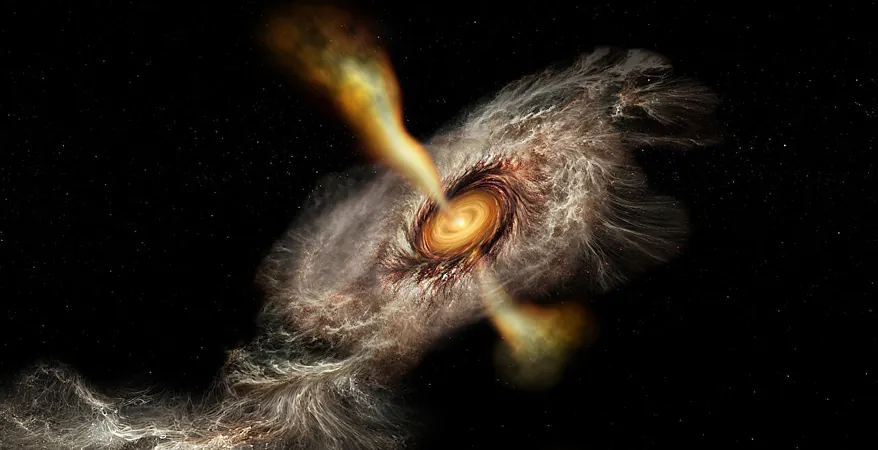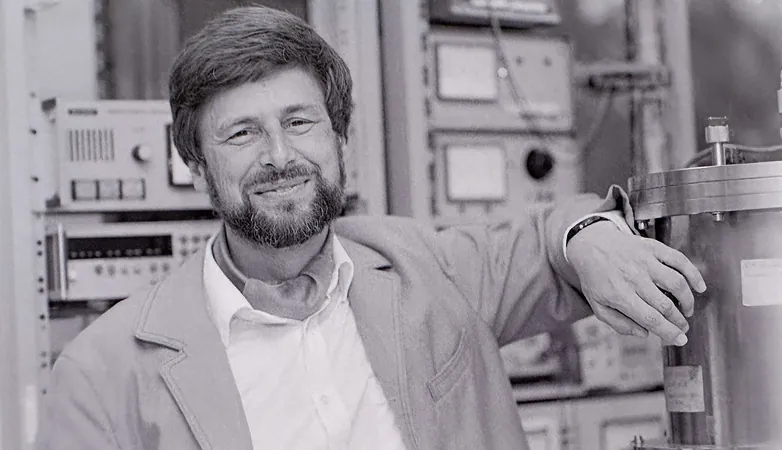
Astronomers Crack the Code of Massive Star Formation Using Ammonia!
2025-05-06
Author: Wei
A Major Breakthrough in Understanding Star Formation
In an exciting announcement, astronomers have unveiled groundbreaking insights into the formation of massive stars using the National Radio Astronomy Observatory's Very Large Array (VLA). For the first time, they have detected an enormous flow of gas surrounding a young star, paving the way for its rapid growth.
Unraveling the Mystery of HW2 in Cepheus A
Focusing on the young star HW2, located an astonishing 2,300 light years from Earth in the Cepheus A region—our galaxy's second closest massive star-forming site—the research team successfully mapped the structure of an accretion disk feeding this stellar giant. This is a pivotal question in astrophysics: how do these titans accumulate their colossal mass before often ending their journey as supernovae?
The Role of Ammonia in Star Formation
Utilizing ammonia (NH3)—a common molecule in interstellar gas clouds and a staple in various industrial applications—the researchers traced gas dynamics critical to HW2. Their observations revealed a scorching hot ring of ammonia gas extending from 200 to 700 astronomical units (AU) around the star, a crucial characteristic that supports existing star formation theories.
Incredible Infall Rates Discoveries!
The most astonishing finding? The gas within this disk is both collapsing inward and spinning around the young star at an exceptional rate of two thousandths of a solar mass per year, marking one of the highest material infall rates ever observed in a forming massive star! This revelation supports the idea that accretion disks can sustain such extreme mass transfer rates even when the star has reached a mass 16 times greater than our Sun.
Expert Insights and Theoretical Alignments
Dr. Alberto Sanna, lead author of the study, emphasized the significance of their observations, stating, "We are witnessing direct evidence that massive stars can form via disk-mediated accretion. The unparalleled sensitivity of the NSF VLA has allowed us to observe intricate details on scales of about 100 AU." The research team's findings matched closely with advanced simulations of massive star formation, as noted by Prof. André Oliva. He explained, "Ammonia gas near HW2 is collapsing at nearly free-fall speeds while rotating at sub-Keplerian velocities, striking a fine balance determined by gravity and centrifugal forces."
Gas Streamers: A Game-Changer?
An intriguing twist emerged from the study as it uncovered structural asymmetries and turbulence within the disk. These features suggest that external gas streams, or "streamers," could be funneling fresh material to one side of the disk. Observations of similar streamers in other stellar nurseries could mean they play a vital role in replenishing accretion disks around massive stars.
Decades of Debate Resolved!
This discovery puts an end to decades of debate regarding whether stars like HW2 can develop accretion disks capable of supporting their prodigious growth. Notably, it reinforces the notion that the same physical processes may govern star formation across various scales of stellar mass.
A Legacy of Inspiration
"HW2 has captivated astronomers for over 40 years, inspiring new generations of researchers," said Prof. José María Torrelles, who played a key role in observing HW2 back in the late 1990s. Thanks to high-sensitivity VLA observations conducted in 2019, the researchers focused on ammonia transitions heated above 100 Kelvin, revealing dense and warm gas near HW2.
The Future of Radio Astronomy
Dr. Todd Hunter from the NRAO remarked on the robustness of radio interferometry in uncovering the hidden dynamics behind the formation of our galaxy's most influential objects. He added, "In ten years, with an upgraded VLA, we will dive even deeper into the circumstellar ammonia characteristics at scales rivaling our solar system!"



 Brasil (PT)
Brasil (PT)
 Canada (EN)
Canada (EN)
 Chile (ES)
Chile (ES)
 Česko (CS)
Česko (CS)
 대한민국 (KO)
대한민국 (KO)
 España (ES)
España (ES)
 France (FR)
France (FR)
 Hong Kong (EN)
Hong Kong (EN)
 Italia (IT)
Italia (IT)
 日本 (JA)
日本 (JA)
 Magyarország (HU)
Magyarország (HU)
 Norge (NO)
Norge (NO)
 Polska (PL)
Polska (PL)
 Schweiz (DE)
Schweiz (DE)
 Singapore (EN)
Singapore (EN)
 Sverige (SV)
Sverige (SV)
 Suomi (FI)
Suomi (FI)
 Türkiye (TR)
Türkiye (TR)
 الإمارات العربية المتحدة (AR)
الإمارات العربية المتحدة (AR)